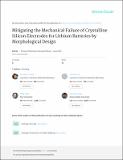| dc.contributor.author | An, Yonghao | |
| dc.contributor.author | Wood, Brandon C. | |
| dc.contributor.author | Ye, Jianchao | |
| dc.contributor.author | Chiang, Yet-Ming | |
| dc.contributor.author | Wang, Y. Morris | |
| dc.contributor.author | Tang, Ming | |
| dc.contributor.author | Jiang, Hanqing | |
| dc.date.accessioned | 2017-10-04T19:17:46Z | |
| dc.date.available | 2017-10-04T19:17:46Z | |
| dc.date.issued | 2015-06 | |
| dc.date.submitted | 2015-03 | |
| dc.identifier.issn | 1463-9076 | |
| dc.identifier.issn | 1463-9084 | |
| dc.identifier.uri | http://hdl.handle.net/1721.1/111789 | |
| dc.description.abstract | Although crystalline silicon (c-Si) anodes promise very high energy densities in Li-ion batteries, their practical use is complicated by amorphization, large volume expansion and severe plastic deformation upon lithium insertion. Recent experiments have revealed the existence of a sharp interface between crystalline Si (c-Si) and the amorphous Li[subscript x]Si alloy during lithiation, which propagates with a velocity that is orientation dependent; the resulting anisotropic swelling generates substantial strain concentrations that initiate cracks even in nanostructured Si. Here we describe a novel strategy to mitigate lithiation-induced fracture by using pristine c-Si structures with engineered anisometric morphologies that are deliberately designed to counteract the anisotropy in the crystalline/amorphous interface velocity. This produces a much more uniform volume expansion, significantly reducing strain concentration. Based on a new, validated methodology that improves previous models of aniso tropic swelling of c-Si, we propose optimal morphological designs for c-Si pillars and particles. The advantages of the new morphologies are clearly demonstrated by mesoscale simulations and verified by experiments on engineered c-Si micropillars. The results of this study illustrate that morphological design is effective in improving the fracture resistance of micron-sized Si electrodes, which will facilitate their practical application in next-generation Li-ion batteries. The model and design approach present in this paper also have general implications for the study and mitigation of mechanical failure of electrode materials that undergo large anisotropic volume change upon ion insertion and extraction. | en_US |
| dc.description.sponsorship | United States. Department of Energy (DE - SC0002626) | en_US |
| dc.publisher | Royal Society of Chemistry (RSC) | en_US |
| dc.relation.isversionof | http://dx.doi.org/10.1039/C5CP01385B | en_US |
| dc.rights | Creative Commons Attribution-Noncommercial-Share Alike | en_US |
| dc.rights.uri | http://creativecommons.org/licenses/by-nc-sa/4.0/ | en_US |
| dc.source | Other repository | en_US |
| dc.title | Mitigating mechanical failure of crystalline silicon electrodes for lithium batteries by morphological design | en_US |
| dc.type | Article | en_US |
| dc.identifier.citation | An, Yonghao et al. “Mitigating Mechanical Failure of Crystalline Silicon Electrodes for Lithium Batteries by Morphological Design.” Physical Chemistry Chemical Physics 17, 27 (June 2015): 17718–17728 © 2015 Royal Society of Chemistry (RSC) | en_US |
| dc.contributor.department | Massachusetts Institute of Technology. Department of Materials Science and Engineering | en_US |
| dc.contributor.mitauthor | An, Yonghao | |
| dc.contributor.mitauthor | Chiang, Yet-Ming | |
| dc.relation.journal | Physical Chemistry Chemical Physics | en_US |
| dc.eprint.version | Author's final manuscript | en_US |
| dc.type.uri | http://purl.org/eprint/type/JournalArticle | en_US |
| eprint.status | http://purl.org/eprint/status/PeerReviewed | en_US |
| dc.date.updated | 2017-10-04T17:24:57Z | |
| dspace.orderedauthors | An, Yonghao; Wood, Brandon C.; Ye, Jianchao; Chiang, Yet-Ming; Wang, Y. Morris; Tang, Ming; Jiang, Hanqing | en_US |
| dspace.embargo.terms | N | en_US |
| dc.identifier.orcid | https://orcid.org/0000-0002-0833-7674 | |
| mit.license | OPEN_ACCESS_POLICY | en_US |
